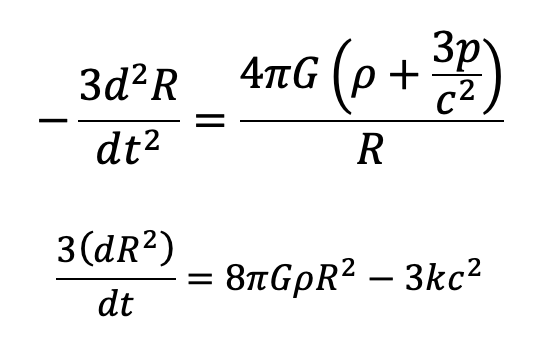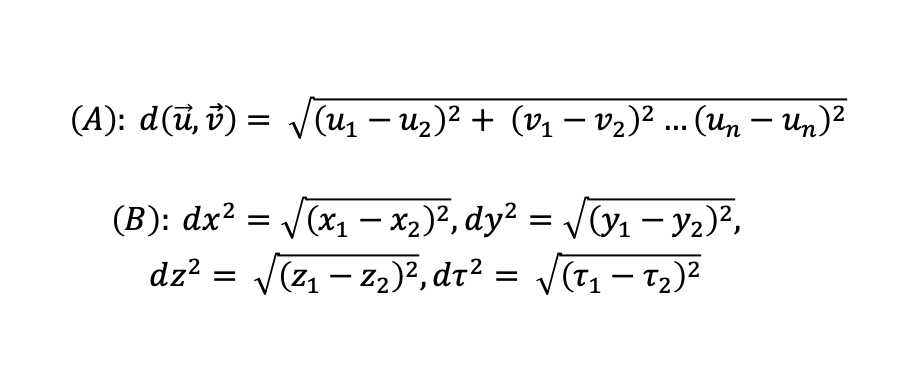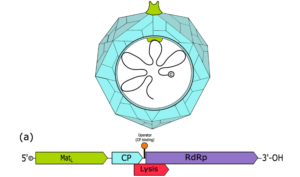
Cover: A simulated timeline of the events since the big bang. The existence of cosmic inflation supports the assumption that the universe must have begun from a single hot singularity with infinite density and gravity. This has led to an investigation of what created this singularity. One proposal, the Hartle-hawking state, offered by the Late astrophysicist Stephen Hawking and astrophysicist James Hartle, hypothesizes that there were no pre-existing conditions leading to the formation of the singularity, but instead the universe inflated from a single point in space and time to fill up the Euclidean spacetime. (Wikimedia Commons, NASA/WMAP Science Team)
Big bang singularity theory
The singularity theory proposes that the big bang was initiated by the explosion of a single, dense, hot point with infinite density and gravity (Pultarova, 2017). The theory has gained validity based on evidence of universe expansion in every direction, which indicates that the universe began from a single point in space and time (Choi, 2017). Furthermore, the cosmic microwave background, which is leftover radiation from the big bang with spots of varying temperature, supports the idea of rapid cosmic inflation and expansion from a single point (Howell, 2018).
The cosmological singularity can be proved mathematically by studying the Friedmann solutions, which have emerged from Einstein’s theory of General Relativity (Tang, 1989):

In this equation, G represents the gravitational constant which is 9.8 m/s, p is the pressure of universal matter being investigated, ρ is the density of matter, R is a factor of universal radius, K is a constant that represents the curvature of space. The value of K in this calculation, for a spherical contracting universe, will be +1 (Menas Kafatos, 1989), and c is the speed of light, which is 3.0 * 108 m/sec.
From the above equation, Tang (1989) assumes that by decreasing the Universal expansion rate, the acceleration (dR2)/dt increases while the factor R decreases until t = 0 and R = 0. Similarly, as the acceleration (dR2)/dt increases, the density of universal matter increases until t = 0 where becomes infinite.
According to the equation, given the conditions assumed to be present at the beginning of the universe and minimizing the universal expansion rate to approximate the state of the universe just before it began to expand, the universe began as a singularity. The implications of this singularity state, however, are a bit disconcerting. In this state, the laws of physics collapse, leaving three paradoxes:
- The energy paradox: Observing the first law of thermodynamics, energy cannot be created nor destroyed but can be transformed from one form to another. How energy was generated and used to drive the big bang and subsequent expansion of the universe is still not understood (Drake, n.d). Therefore, ambiguity still exists on what created, transformed, and drove matter from the singularity to the current diverse matter in the cosmos.
- Matter-antimatter Annihilation paradox: According to the standard model of particle physics, space is filled with virtual particles: matter and anti-matter particles, that are constantly materializing in pairs, separating, and coming together again. By meeting, they annihilate each other. Therefore, the universe should have destroyed itself at the very beginning after dense matter emerged from a singularity (Atkinson, 2017). Obviously, this did not happen, and scientists are not sure why.
- High gravity paradox: The singularity, by its definition, is assumed to be a point of infinite density and gravity. Therefore, the matter must have been bounded by an exceptionally strong gravitational force. In order for universal expansion to occur, particles had to achieve an escape velocity greater than the speed of light (3.0 x 108 m/sec or 6.7 x 108 miles per hour) to escape this gravitational force (Zombeck, 2003). What the initial velocity of the particles emanating from the singularity was, and how this initial velocity was attained, are still facts unknown.
The Hartle-Hawking state
Remarking on these uncertainties about the big bang, Stephen Hawking once wrote: “Events before the Big Bang are simply not defined, because there’s no way one could measure what happened at them. Since events before the Big Bang have no observational consequences, one may as well cut them out of the theory and say that time began at the Big Bang.”
The Hartle-Hawking state, as first proposed in 1996 and continuously refined until 2018 when Steven Hawking passed away, argues that instead of a pre-existing boundary, the universe simply inflated from a single point in space and time (Hawking, 1996). The Hartle-Hawking state establishes a no-boundary condition for the formation of the universe. Boundaries are hypothetical and pre-existing conditions before the big bang that would have shaped the big bang event.
To understand the Hartle-Hawking state, three concepts need to be understood: the Theory of General Relativity, Minkowski spacetime, and imaginary time. The Minkowski spacetime continuum, devised by German mathematician Hermann Minkowski [1864-1909], can be thought of as a four-dimensional framework with 3 dimensions of space (x, y, and z) and one dimension of time (t).

Figure 1: A representation of the Minkowski spacetime using the horizontal positioning reference of an object: x. Minkowski adds time, ct, into the framework, making spacetime a 4D figure. In Minkowski’s map of the universe, the position of an object in the universe is not only asserted by its 3D position but also by time. (Wikimedia Commons, Mike Run)
The Theory of General Relativity, formulated by Albert Einstein [1879-1955] in 1915 and building from the theories of Minkowski, states that the spacetime continuum is not flat but curved by matter within it. As they move through Minkowski spacetime, objects in the universe warp and stretch spacetime as if it was a sheet of fabric because they have mass.

Figure 2: An artist’s concept of Gravity Probe B orbiting the Earth to measure space-time, a four-dimensional description of the universe including height, width, length, and time. The earth as seen is exerting mass on the spacetime, creating a curvature which is described by the General Theory of Relativity. (Wikimedia commons, Henze NASA)
Finally, imaginary time is a concept invented by Gian Carlo Wick that multiplies real-time by an imaginary unit, i, through a process called Wick’s rotation (Kulkarni, 2019). The Hartle-Hawking state treats time as imaginary prior to the big bang, and thus the transformation is necessary to perform calculations for the state.

Figure 3: Wick rotation. Real-time, t1, is converted to imaginary time through this transformation t = iτ which makes τ = t/i. Therefore the point on the y-axis can be labeled as t1 which is imaginary time (Wikimedia commons, Gernot Münster)
Mathematical calculation
The equations below will adjust the real-time Minkowski space-time equations to incorporate imaginary time and provide support for the Hartle-Hawking state.
Assumptions:
Atoms are neither created nor destroyed in any chemical reaction, according to Law of the Conservation of Mass formulated by British chemist John Dalton in the early 19th century. Therefore, these calculations will assume an atom that existed before the big bang continued to exist after the Big Bang, and was not destroyed by the process.
An atom is always randomly moving from one point to another at any time (Cox, 2021). Therefore, the calculation will assume that before the big bang an atom was at position 1 and 2, and participated in events s1 and s2
- Imagine an atom before the big bang at position S1, and at position S2 when universal contraction is simulated towards the root of the big bang.
- An atom at S1 can be assumed to have the following attributes in spacetime x1, y1, z1, and time t1 while at S2 it can have the following attributes x2, y2, z2 and t2
- The Minkowski space-time equation, s2 = x2 + y2 + z2 + t2, can be used to calculate the 4D positional difference between materials in 3D spacetime
- Since time is consider imaginary before the big bang, we will replace and with imaginary time τ1 and τ2 using the wick’s rotation: τ = t/i and i = sqrt(-1)
- Having determined and , we will now calculate the interval, or the 4D distance of separation between two events in spacetime, between S1 and S2. The interval will be calculated using the Minkowski metric equation, and assigned the value ds.
- To find the positional difference between vectors, in this case S1 and S2, the euclidean n-spacetime equation (A) is used (with u and v standing in for S1 and S2):
- After working out the 3D positional difference and imaginary time difference through equation (B), the answer is: sqrt(ds2 = dx2 + dy2 + dz2 + dτ2)


Figure 4: Minkowski space time diagram showing the transformation of object S in spacetime to s’ in imaginary time τ. (Image source: wikimedia commons, Maksim)
Following this equation, Hawking and Hartle (2018) asserted that , the interval between atomic events and as you approach the origin of the big bang, will always be a never-ending calculation because it yields a conclusion that the origin of the universe is a eucledian spacetime closed loop with no start. Or consider a more familiar analogy – the Big Bang is simply the starting point of the universe, just as the South Pole is simply the southernmost point of the Earth. There is nothing South of the Earth’s Southernmost point – and in the Hawking-Hartle theory, there is nothing else before the big bang.

Figure 5: Comparison of the Hartle-Hawking state and the standard big bang singularity model (Image source: Wikimedia Commons, unbounded rationality)
Conclusion
The Hartle-Hawking state also has been labeled as ambiguous and mathematically impossible. For instance, Page (2007), argues that the Hartle-Hawking state would presumably form an empty universe contrary to real-time observations due to excessive inflation. Dark matter which is the source of inflation would have given rise to a larger 4D euclidean swamping the universal material that we currently observe.
Other theories, that we explain the formation of the universe are:
- The big bounce theory
- The Tunnelling theory
References
- Page, D. N. (2007). Susskind’s challenge to the Hartle–Hawking no-boundary proposal and possible resolutions. Journal of Cosmology and Astroparticle Physics, 2007(01), 004–004. https://doi.org/10.1088/1475-7516/2007/01/004
- Atkinson, N. (2017, October 26). The Universe Should Have Destroyed Itself at the Big Bang Why Didn’t It? Seeker. https://www.seeker.com/space/astrophysics/the-universe-should-have-destroyed-itself-at-the-big-bang-why-didnt-it
- Carlip, S. (2014, December 5). The Hartle-Hawking “no boundary” proposal. Physics LibreTexts. https://phys.libretexts.org/Bookshelves/Astronomy__Cosmology/Supplemental_Modules_(Astronomy_and_Cosmology)/Cosmology/Carlip/The_Hartle-Hawking_%22no_boundary%22_proposal
- Cox, G. (2021, February 10). Particles are in constant motion. What propels them? New Scientist. https://www.newscientist.com/lastword/mg24933211-300-particles-are-in-constant-motion-what-propels-them/
- P. 05. (2017, December 6). What If the Big Bang Wasn’t the Beginning? New Study Proposes Alternative. Space.com. https://www.space.com/38982-no-big-bang-bouncing-cosmology-theory.html#:~:text=The%20universal%20origin%20story%20known
- Gordon W.F. Drake. (2018). thermodynamics | Laws, Definition, & Equations. In Encyclopædia Britannica. https://www.britannica.com/science/thermodynamics
- Harvard. (n.d.). –Universe Forum–Big Bang–What powered it? Lweb.cfa.harvard.edu. https://lweb.cfa.harvard.edu/seuforum/bb_whatpowered.htm
- Hawking, S. (1996). Stephen Hawking. Www.hawking.org.uk. https://www.hawking.org.uk/in-words/lectures/the-beginning-of-time
- Howell, E. (2017, November 7). What Is the Big Bang Theory? Space.com. https://www.space.com/25126-big-bang-theory.html
- Kotz, J. C., & Treichel, P. M. (2018). chemical reaction | Definition, Equations, Examples, & Types. In Encyclopædia Britannica. Britannica. https://www.britannica.com/science/chemical-reaction
- Kulkarni, A. (2019, November 21). What Is Imaginary Time?» Science ABC. Science ABC. https://www.scienceabc.com/pure-sciences/what-is-imaginary-time.html
- Menas Kafatos. (1989). Bell’s Theorem, Quantum Theory, and Conceptions of the Universe (pp. 211–214). Springer Netherlands. https://link.springer.com/chapter/10.1007/978-94-017-0849-4_33
- Tang, P. C. L. (1989). The Ontological Status of the Cosmological Singularity. Bell’s Theorem, Quantum Theory, and Conceptions of the Universe, 211–214. https://doi.org/10.1007/978-94-017-0849-4_33
- Wang, B. (2018, May 2). Hawking talks about no clear Big Bang and no boundary to space-time | NextBigFuture.com. Nextbigfuture.com. https://www.nextbigfuture.com/2018/03/hawking-talks-about-no-clear-big-bang-and-no-boundary-to-space-time.html
- Zombeck, M. (2003, September 22). According to the big bang theory, all the matter in the universe erupted from a singularity. Why didn’t all this matter–cheek by jowl as it was–immediately collapse into a black hole? Scientific American. https://www.scientificamerican.com/article/according-to-the-big-bang/
Related Posts
Failures of Facial Recognition Amid Widespread Masking
Cover Image: Signs similar to this one have become increasingly...
Read MoreConsidering the Microbiota-Gut-Brain-Axis in Cancer Research
Lead Author: Jillian Troth1 Co-Authors (alphabetical order): Roxanna Attar2, Julia Gainski3,...
Read MoreThe Influence of Language on the Perception of the World
Figure 1: The Influence of Language on the Perception of...
Read MoreThe Microbiota-Gut-Brain Axis May Be the Missing Link Between Autism Spectrum Disorder and Anorexia Nervosa
Figure 1: The microbiota-gut-brain axis is a bidirectional pathway of...
Read MoreThe Next Source of Antibiotics: Viruses
Figure 1: A computer-generated image of a bacteriophage called a...
Read MoreThe Gut May Be The Door to Effective Depression Treatment
First Author: Jillian Troth1 Co-Authors [Alphabetical Order]: Roxanna Attar2, Caroline...
Read MoreFrankline Misango Oyolo






